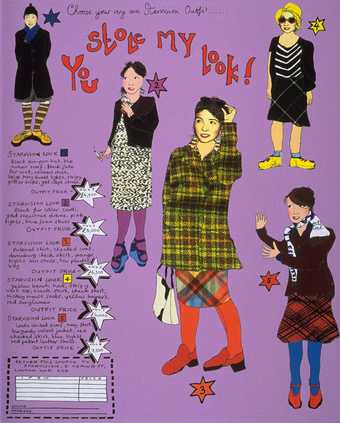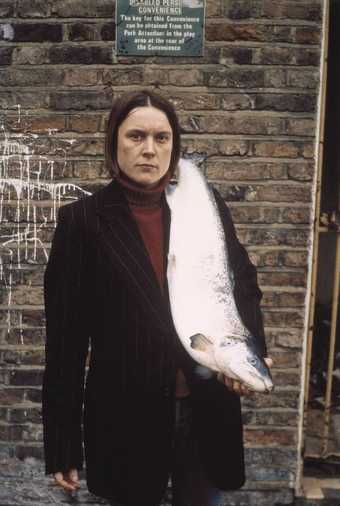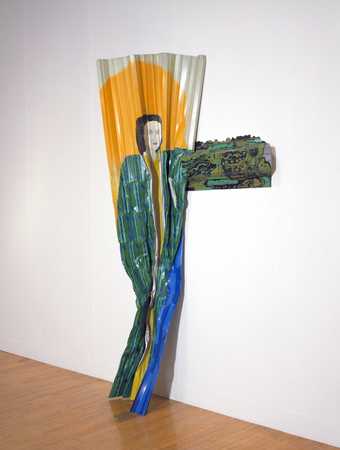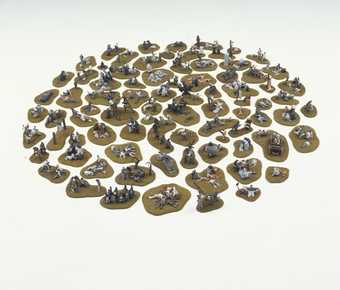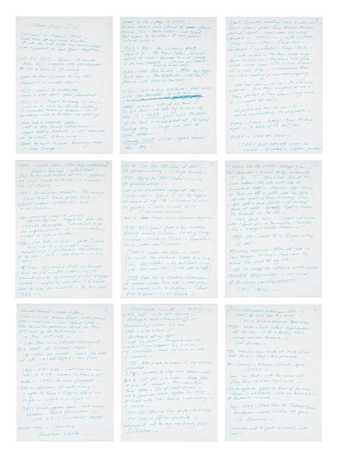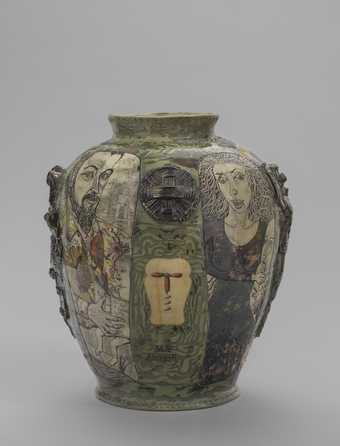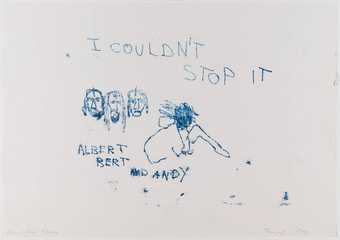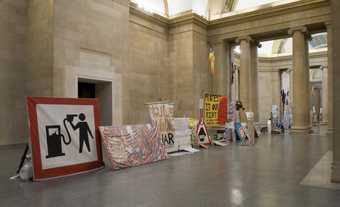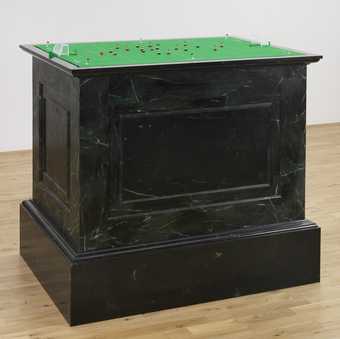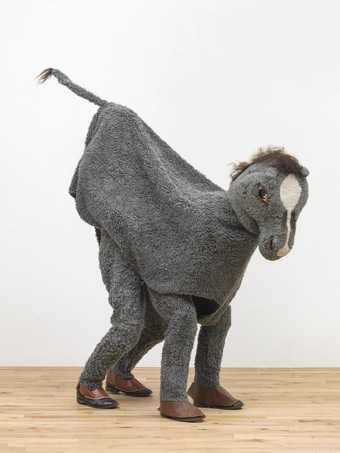Not on display
- Artist
- Sir Grayson Perry CBE RA born 1960
- Medium
- Earthenware
- Dimensions
- Object: 550 × 410 × 410 mm, 17 kg
- Collection
- Tate
- Acquisition
- Purchased from Laurent Delaye Gallery with assistance from David and Janice Blackburn 2002
- Reference
- T07904
Summary
Aspects of Myself is a large glazed ovoid-shaped vase that tapers to a narrow neck at its top. The vase has a patchy gold and yellow glaze on its surface onto which are painted an array of figures of varying sizes in dark outline, coloured in with a blue metallic glaze. Each figure stands or sits alone and looks out at the viewer, and some of these characters appear in ordinary poses in everyday settings – for instance, a teenage boy holds a bunch of flowers and a man rides a motorcycle – while others are of a more sinister nature, such as the bound and gagged woman shown towards the bottom of one side of the vase. Among the blue figures are painted numerous tiny red and brown bodies wearing dresses, which multiply and become more mummy-like in appearance towards the neck of the vase. Across the piece are painted rust-brown depictions of a small village clearing that features a penis-shaped house, and branded over the top of all of the images are golden symbols of a racing car, a man on a motorcycle, the artist’s transvestite alter-ego, Claire, and his childhood teddy bear, Alan Measles. When encountered in a gallery setting, the bright yellow and gold of the work’s background highlights the irregular shape of the vase, giving it an unstable appearance. Although the vase is large, viewers are required to stand very close to it to see the details of the figures and scenes depicted in the various layers of glaze.
The vase was made in London in 2001 by the British artist Grayson Perry. He made it by building up the pot’s shape in clay using a coiling method and then placing layers of coloured slip, lustre glaze and ceramic transfers onto the work, which he then fired in a kiln multiple times at low temperatures. To create the strong dark lines of the large blue figures, Perry made indentations in the clay using a potter’s knife. He then covered these marks with a black slip before scraping back the surface, leaving behind the dark grooves that define the figures’ edges.
The title Aspects of Myself suggests that the figures on the vase are representations of the several different personae that make up the artist’s character. Perry had undergone a course of psychotherapy in 1998, shortly before he made this work, and he has explained that Aspects of Myself depicts the various ‘selves’ that he had identified during these psychotherapeutic sessions, stating in 2002 that the work ‘mirrors my self awareness in that traits in my personality I previously attributed to “mystical” outside forces I later took ownership of’ (Grayson Perry, letter to Tate conservation department, 2002, Tate Acquisition file). Among the many facets of his personality that Perry has depicted, Alan Measles and Claire appear most frequently. Perry has given prominence to Alan Measles in his work throughout his career, yet it was only after undergoing therapy that Perry realised how fundamental Alan’s role was to his own personality:
In the course of visiting a psychotherapist I was to discover that Alan was of course more to me than a mere cuddly toy or even a fantasy leader, he was my surrogate father. Onto him I projected all the positive male characteristics that I found lacking in my real world. As a child when playing I took on the role of his bodyguard, so precious was he as a spiritual receptacle, part of my own personality.
(Perry 2011, p.80.)
As Perry’s father figure, the artist has observed, ‘Alan Measles represents my maleness’ (Perry 2011, p.80). Conversely, Perry’s female alter-ego Claire ‘is associated with feelings seen as predominantly female’ (Perry 2011, p.80). Since receiving therapy, Perry has featured these two together frequently in his work, stating in 2011 that this is because ‘Many problems we encounter in society come from an imbalance in the way these two sides of our personalities are dealt with’ (Perry 2011, p.80).
Aspects of Myself features many of the same motifs as are seen in another of Perry’s vases in the Tate collection, My Gods 1994 (Tate T07940). Both works depict sadomasochistic characters, men riding motorcycles and a male figure named Alan who is linked with childhood and imagination. However, compared to the earlier My Gods, the figures in Aspects of Myself appear to have lost some of the fraught torment they possessed in My Gods. Here there are fewer images of violence, and the figures are depicted in similar colours and styles to one another, creating a sense of harmony rather than fear or discord. These visual distinctions between the two works suggest that Perry’s perception of his previous motifs and concerns changed as a result of psychotherapy. The art historian Jacky Klein has discussed the personal and creative transition Perry went through at this time: ‘one thing that certainly came more easily was an understanding and acceptance of his transvestism … he now recognises therapy as having been one of the most significant factors in his artistic development’ (Klein 2009, p.173).
Further reading
Wendy Jones and Grayson Perry, Grayson Perry: Portrait of the Artist as a Young Girl, London 2006.
Jacky Klein, Grayson Perry, London 2009.
Grayson Perry, Grayson Perry: The Tomb of the Unknown Craftsman, London 2011.
Michal Goldschmidt
October 2014
Supported by Christie’s.
Does this text contain inaccurate information or language that you feel we should improve or change? We would like to hear from you.
Display caption
Grayson Perry's ceramic vases and pots combine a variety of decorative techniques to address issues of identity, class, sexuality and gender. They often present a sharply satirical view of society and, in particular, the art world. Aspects of Myself is an autobiographical work showing the artist in the guise of his transvestite alter-ego 'Claire'. Perry''s visually and thematically complex work challenges the traditional division between fine art and the applied arts.
Gallery label, October 2002
Does this text contain inaccurate information or language that you feel we should improve or change? We would like to hear from you.
Film and audio
Explore
- emotions, concepts and ideas(16,416)
-
- emotions and human qualities(5,345)
- actions: postures and motions(9,111)
-
- arms folded(137)
- standing(3,106)
- self-portraits(888)
- crime and punishment(436)
-
- bound(43)
- transvestism(29)
You might like
-
Georgina Starr You Stole my Look
1997 -
Gillian Wearing CBE The Garden
1997 -
Sarah Lucas Got a Salmon On #3
1997 -
Kate Blacker Made in ‘84
1984 -
Marc Quinn No Visible Means of Escape IV
1996 -
Mark Wallinger Angel
1997 -
Jake Chapman, Dinos Chapman Disasters of War
1993 -
Tracey Emin Tracey Emin C.V.
1995 -
Mark Wallinger Hymn
1997 -
Sir Grayson Perry CBE RA My Gods
1994 -
Mark Wallinger Threshold to the Kingdom
2000 -
Tracey Emin Albert, Bert and Andy (I couldn’t stop it)
1997 -
Mark Wallinger State Britain
2007 -
Mark Wallinger They Think It’s All Over... It Is Now
1988 -
Mark Wallinger Behind You!
1993


